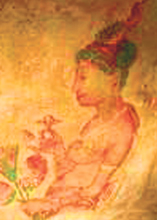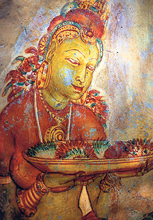An incident which shocked the entire country took place forty years ago. On October 14, 1967, vandals attacked the world famous Sigiriya frescoes – an act which no one could
understand why. The Government took urgent action to obtain the
services of experts to restore the affected paintings. An expert from Italy managed to save the
frescoes.
Sigiriya dates back to the 5th century A.D and is identified as a rock fortress built by King Kassapa (473–491) after killing his father, Dhatusena to grab the throne. Just as much as the task of building a royal palace atop a rock 200 metres high is an amazing feat, so is the
collection of fresco
paintings of immeasurable beauty.
The frescoes are found in a cave on the face of the rock. The fact that the
frescoes have lasted for the past 1500 years is
remarkable. They still maintain the beautiful original shades which are mainly golden and bluish. The female figures are
decorated with exquisite jewellery and flowers. Attractive ornaments can be seen on their necks, ears and hands. They
obviously portray the
ornaments used at that time.
The female figures in the frescoes appear either in twos or singly.
The first person in
modern times to locate the paintings was an engineer named Murray attached to the Public Works Department (PWD). He had made tracings, copied them in pastel and published a paper in 1891. The first detailed study has been by the first Archaeological Commissioner, H. C. P. Bell after 1894.
Renowned archaeologists, historians and researchers have given
different interpretations to the frescoes. According to H. C. P.
Bell, they represent females in King Kassapa's court who are going in procession to the Pidurangala temple
carrying flowers in their hands. Kassapa's queens lamenting over the king's death is the interpretation given by Dr. Nandadeva Wijesekera.
The doyen of Sinhala literature Martin Wickremasinghe sees them as females engaged in water sports. Stating that Sigiriya is the replica of 'Alakamandava,' the abode of God Kuvera,
Dr. Senerat Paranavitane interprets the frescoes as
representing the princess of lightning Vijjukumari and cloud damsels Meghalata. To Dr. Ananda Coomaraswamy, they are 'apsaras' or angels in the South Asian tradition.
The most acceptable theory to most scholars is Dr.Coomaraswamy's explanation. 'Apsaras' are often represented in art and literature as celestial beings who carried flowers and scattered them over kings and heroes as a
celebration of victory and heroism, states researcher Dr. Senaka Bandaranayake. "We can say with certainty that the Sigiriya ladies are celestial nymphs," he says.
The frescoes,
comparable to the famous Ajanta frescoes in India, are situated over 100 metres above ground level and can be reached through a spiral staircase. Out of over 500 original paintings only around twenty can be seen today. It would have been a gigantic picture gallery. |


